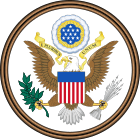Corolla Wild Horses Protection Act facts for kids
 |
|
| Full title | To direct the Secretary of the Interior to enter into an agreement to provide for management of the free-roaming wild horses in and around the Currituck National Wildlife Refuge. |
|---|---|
| Introduced in | 113th United States Congress |
| Introduced on | January 3, 2013 |
| Sponsored by | Rep. Walter B. Jones (R, NC-3) |
| Number of co-sponsors | 0 |
| Agencies affected | United States Department of the Interior, National Park Service |
| Legislative history | |
|
|
The Corolla Wild Horses Protection Act (H.R. 126) was a special bill. It was introduced in the 113th United States Congress. This bill was created to help protect the wild horses. These horses live in North Carolina. The bill passed in the United States House of Representatives.
Contents
Protecting Wild Horses
This bill is all about keeping a special group of wild horses safe. These horses live in a place called the Currituck National Wildlife Refuge. The bill helps make sure they have a good home. It also ensures they are cared for properly.
Who are the Banker Horses?
The wild horses in North Carolina are called Banker horses. They are a special type of horse. These horses are feral, which means they live in the wild but came from domesticated horses long ago. Banker horses are usually small and strong. They also have a calm and gentle nature.
These horses are believed to be descendants of Spanish horses. They might have come to America in the 1500s. Some stories say they survived shipwrecks. Others suggest they were left on the islands by early explorers.
Where Do They Live?
About 400 Banker horses live on the Outer Banks of North Carolina. The Outer Banks are long, narrow islands. They are separated from the mainland by water. These islands can be far from the shore. Most are less than one mile (1.6 km) wide.
The land on these islands is not very rich. It has mostly tough grasses. There are also a few small, stunted trees. Each island is separated from the next by a tidal inlet. This means water flows between them.
Why Did They Need Protection?
In the 1980s, a town called Corolla grew a lot. This meant the wild horses on Currituck Banks started meeting humans more often. Sadly, by 1989, eleven Banker horses were hit and killed by cars. This happened on a new road called Highway 12.
Moving the Horses for Safety
Because of these accidents, a group was formed. It was called the Corolla Wild Horse Fund. This group works to protect the horses. They moved the remaining horses to a safer part of the island. This area was fenced off. It included 1,800 acres (7.3 km²) of land. This land was both federal and privately owned.
The local leaders in Corolla declared this area a wild horse sanctuary. Today, the horse population is managed. Young horses, called yearlings, are adopted out. This helps keep the herd at a healthy size. Even with these efforts, there were still disagreements about how to protect the horses. This led to the new law in 2013.
What Does the Bill Do?
The Corolla Wild Horses Protection Act was created to help manage these wild horses. It tells the United States Secretary of the Interior to work with several groups. These groups include the Corolla Wild Horse Fund and Currituck County. They also include the state of North Carolina. Together, they manage the free-roaming wild horses. These horses live in and around the Currituck National Wildlife Refuge.
Managing the Herd
The bill sets out clear rules for managing the horses.
- It says there should be no more than 130 wild horses in the area.
- It makes sure the horses are managed in a way that doesn't cost too much money.
- It allows for new horses to be brought in. These horses would come from the herd at Cape Lookout National Seashore. This helps keep the herd healthy. It ensures they have enough different genes (called genetic viability).
- The Corolla Wild Horse Fund has to pay for some costs. These include the horses' health care, upkeep, and moving them if needed.
Keeping the Horses Healthy
The bill also has rules about moving horses from Cape Lookout. Horses can only be moved with approval. This approval comes from the Foundation for Shackleford Horses Inc. It must also follow their plans for the Shackleford Banks Horse Herd.
Finally, the bill states that the U.S. government is not responsible for any damage. This means if the wild horses cause damage to people or property, the government is not legally liable.
How a Bill Becomes a Law
A bill is an idea for a new law. It has to go through several steps to become a law. First, it is introduced in Congress. Then, it goes to committees for review. After that, it is voted on by the House and Senate.
In the House of Representatives
The Corolla Wild Horses Protection Act started in the United States House of Representatives. It was introduced on January 3, 2013. A representative named Walter B. Jones, Jr. from North Carolina introduced it.
The bill was sent to two committees. These were the United States House Committee on Natural Resources and a special subcommittee. These groups studied the bill. On June 3, 2013, the bill passed the House. It passed by a voice vote. This means members said "aye" or "no" out loud, and the speaker decided the majority.
What Happened in the Senate?
After passing the House, the bill moved to the United States Senate. It was received by the Senate on June 4, 2013. For a bill to become a law, it needs to pass both the House and the Senate.

